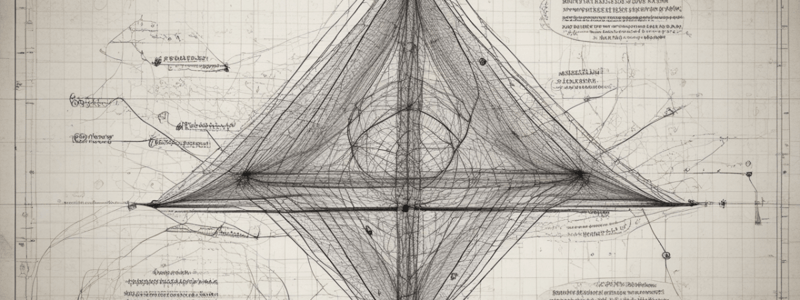Podcast
Questions and Answers
What is the formula to calculate the gradient of a line passing through two points (x₁, y₁) and (x₂, y₂)?
What is the formula to calculate the gradient of a line passing through two points (x₁, y₁) and (x₂, y₂)?
- Gradient = (x₂ - x₁) / (y₂ - y₁)
- Gradient = (y₂ + y₁) / (x₂ + x₁)
- Gradient = (x₂ + x₁) / (y₂ + y₁)
- Gradient = (y₂ - y₁) / (x₂ - x₁) (correct)
What is the purpose of a flow diagram in representing a function?
What is the purpose of a flow diagram in representing a function?
- To algebraically express the function
- To show the calculations needed to transform input into output (correct)
- To display the values of input and corresponding output
- To provide a visual representation of the function
What is the term for the value substituted into a function?
What is the term for the value substituted into a function?
- Input Number (correct)
- Function Value
- Variable
- Output Number
What is the key feature of a graph that indicates the rate of change between variables?
What is the key feature of a graph that indicates the rate of change between variables?
What is the term for the result after applying the function to the input?
What is the term for the result after applying the function to the input?
What is the primary purpose of a graph in representing a relationship between variables?
What is the primary purpose of a graph in representing a relationship between variables?
What is the term for the specific output corresponding to a given input?
What is the term for the specific output corresponding to a given input?
What is the term for a quantity that can change?
What is the term for a quantity that can change?
What is the term for the points where the graph crosses the axes?
What is the term for the points where the graph crosses the axes?
What is the term for whether the graph is a continuous line or has breaks/discontinuities?
What is the term for whether the graph is a continuous line or has breaks/discontinuities?
Which of the following representations is most useful for identifying patterns in a relationship between variables?
Which of the following representations is most useful for identifying patterns in a relationship between variables?
A function has a gradient of 2. What can be inferred about the relationship between the input and output?
A function has a gradient of 2. What can be inferred about the relationship between the input and output?
Which of the following types of graphs is most suitable for representing a relationship that has a constant rate of change?
Which of the following types of graphs is most suitable for representing a relationship that has a constant rate of change?
What is the primary advantage of using a graph to represent a relationship between variables?
What is the primary advantage of using a graph to represent a relationship between variables?
Which of the following features of a graph is most indicative of a discontinuous relationship?
Which of the following features of a graph is most indicative of a discontinuous relationship?
A function has a continuous graph with a constant positive gradient. What can be inferred about the relationship between the input and output?
A function has a continuous graph with a constant positive gradient. What can be inferred about the relationship between the input and output?
Which of the following representations of a function is most useful for identifying the maximum or minimum value of the output?
Which of the following representations of a function is most useful for identifying the maximum or minimum value of the output?
What is the primary advantage of using a table to represent a function?
What is the primary advantage of using a table to represent a function?
A function has a graph with a non-zero intercept on the y-axis. What can be inferred about the relationship between the input and output?
A function has a graph with a non-zero intercept on the y-axis. What can be inferred about the relationship between the input and output?
Which of the following types of graphs is most suitable for representing a relationship that has a non-constant rate of change?
Which of the following types of graphs is most suitable for representing a relationship that has a non-constant rate of change?




